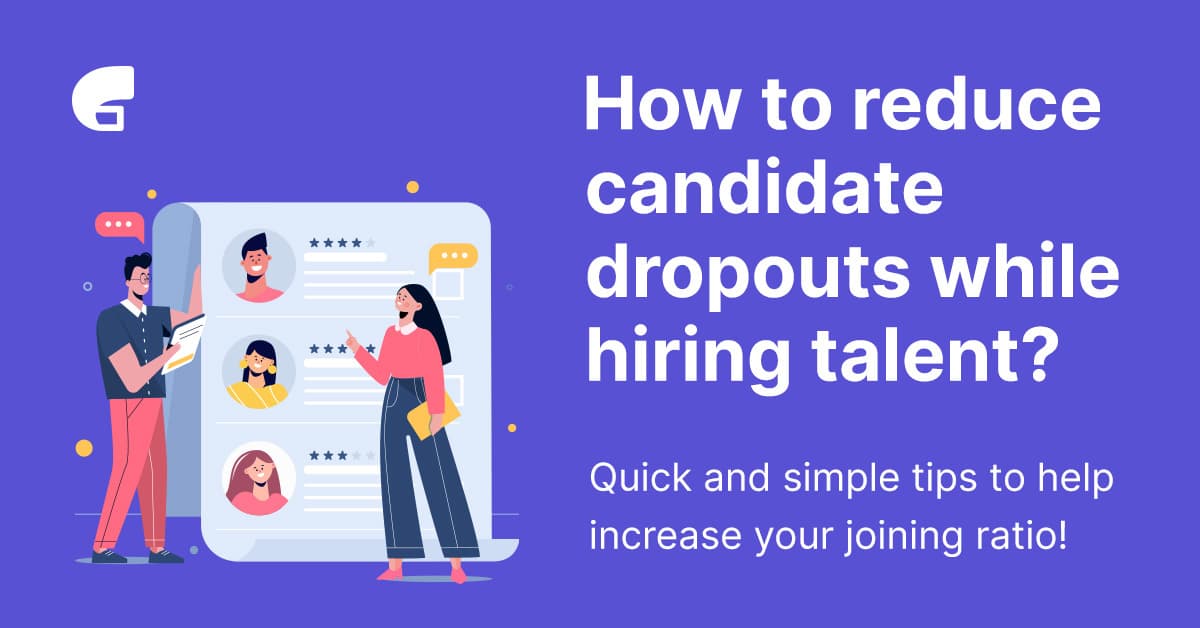Quick and simple tips to help increase your joining ratio!
Offers being rejected is the last thing a recruiter wants at the end of an excruciating process of finding, interviewing, and negotiating the right candidate for an open position. While one-off rejections can happen due to changes in the external circumstances but it’s a cause of concern if it becomes regular.
This problem is not new but it’s getting worse, especially in the technology hiring space. The tech industry is growing rapidly, making up to 35% of the world market as of 2022. Considering how crucial hiring the right people is to a company’s growth and success, it is no surprise that tech employers are investing heavily in recruitment and many of them face the disappointment of seeing candidates drop out at the last minute.
Conversely, while the demand for suitable candidates for a variety of tech roles is swiftly increasing, the joining ratio has dipped more than 50% across several skills. The numbers are stark. In internal surveys, companies have reported a similar trend across seniority levels and sub-functions in the engineering teams.
Why do candidates reject job offers at the seeming end of the hiring process? Broadly, it’s due to an expectation mismatch that can be fixed if companies build their recruitment funnels around the candidates rather than their seemingly unending wish lists.
The situation has become worse in the aftermath of COVID since candidates now prefer to work with remote/hybrid companies. But there’s also a deep-rooted rot in the current hiring structures that aren’t candidate-friendly and do not exactly account for the talent demand and supply dynamics, aspirations of the candidates, or even perks beyond salary.
So what can recruiters and leadership teams do to improve their joining ratio and keep last-minute drop-offs to a minimum? Let’s look at some ideas.
Company fitment:
If a company doesn’t align with the candidate’s values or needs at the time, it is more likely they will reject an offer.
A well-crafted job description that outlines a company’s requirements, or a blog post describing an ideal candidate will help attract suitable applications. Making this explicit at the outset could result in significantly lesser applicants – but as they say, it’s about quality, not quantity. Employee expectations should be clearly spelled out in the job description so that both the employer and the applicant are on the same page leading to fewer misunderstandings further down the line. Having one or two “must-have” qualifiers in the job description helps to ensure people who are clearly a mismatch for the role are less likely to apply.
Bottom line: Don’t rush past the hiring process and give the candidates a fair opportunity to gather all the relevant details about the company – including teh funding, roadmap, vision as well as day-to-day stuff such as actual role and responsibilities, to attract only the relevant candidates instead of stuffing the recruitment funnel with irrelevant candidates.
Company culture:
Company culture is an important factor for 46% of job seekers, while 86% of job seekers avoid companies that have a bad reputation.
Providing the candidate with information about the role, their team dynamics, and employee well-being initiatives during the interview stage sets the right expectations at the outset. This also includes writing job descriptions that filter out irrelevant candidates at the outset. Great recruiters often spell out explicitly why someone shouldn’t join that company and provide factual data points to ensure that people who shouldn’t apply for a job do not get inside the hiring funnel at all.
Meanwhile, the company culture is not just the perks on offer but it’s the amalgamation of the quality of work, working styles, colleagues, diversity, and opportunities for growth. Companies with good marketing but bad cultures often get discovered sooner than later and candidates are unlikely to join if they aren’t convinced that the workspace will add positively for their wellbeing and growth.
Opportunities to interact with existing employees in an unbiased manner will also give the applicant clarity about the culture and ensure no unpleasant surprises later.
Bottom line: Expose culture early in the hiring process and mince no words. Whether you are office-only, work 6 days a week, or expect longer-than-normal working hours – let the candidates know along with your reasons why to avoid being negatively viewed later in the hiring process.
Tech stack:
An outdated tech stack can put off professionals who fear their skillset becoming obsolete and unmarketable, making them want to work with the latest and most in-demand technologies.
To counteract this, it helps if companies expose not just their stack but the engineering team to the candidates early in the hiring process. It builds trust and weeds out candidates that aren’t liekly to work on a certain technology. At the same time, the company also gets an opportunity to talk about its technology upgrade roadmap, if any. If this isn’t the case, there should be a compelling reason which is communicated to candidates.
The employer could also demonstrate innovative products they’ve built with their existing tech stack, indicating how the candidates would also benefit from doing this and developing their skillsets.
Bottom line: Update those legacy technology builds to newer languages if you want to attract the best talent. Most good candidates prefer working on the latest technology and there’s no substitute for reducing the technology debt to recruit the smartest people.
Remuneration:
While a salary wouldn’t necessarily be a deal-breaker, if a company is paying a non-competitive or low wage that is considerably less than the ‘going rate’, it indicates that it doesn’t value its workforce. The employer needs to be in tune with the market rates for the skillsets being hired.
In a candidate-driven market, transparency about compensation models helps applicants make an informed decision about whether to apply for a role, starting out with a low salary offer could put off good candidates from even applying. At the same time, despite compensation being an important factor to accept a new job, 27% of tech professionals would accept a lower salary in exchange for company stock.
In addition, paid time off, flexible working schedules, and health insurances are among the most important benefits for employees. A healthy balance between compensation and other benefits will go a long way in attracting the ideal candidates.
For benchmarking salaries, you could also use our salary reckoner published after researching thousands of companies and candidates. You can access it here in our tech hiring e-book.
Bottom line: Attracting the right candidate is easily achieved by making the recruitment funnel applicant-focused and supporting their discovery of the company earlier in the process. While it may seem like a significant effort, the long-term returns make it worthwhile.
P.s: We had written about the importance of reverse interviewing and how it can help reduce dropouts from the hiring funnel. You can read that piece here.





